It’s no secret that marketing artists are avid admirers of alliteration. In that spirit, we’re about to share a trade secret with you: the 5 C’s of marketing.
What Are the 5 C’s of Marketing?
In a nutshell, the 5 C’s of marketing is a situation analysis framework for helping you determine the strengths and weaknesses of your brand, relative to the field in which you operate. As a good guideline for marketing strategies, this mnemonic consists of five terms, and it typically includes: company, customers, competitors, collaborators and climate.
A 5C analysis, alongside other widely used business tools like the SWOT analysis (strengths, weaknesses, opportunities and threats), serves as a method for helping professionals make decisions and construct actionable marketing strategies. Often, a defined marketing plan will include instructions for undertaking a review of the 5 C’s at regular intervals, such as every six months or on an annual basis.
Sound complicated? Just stick with us. By the time we’re done, C-C-C-C-C will seem as simple as A-B-C.
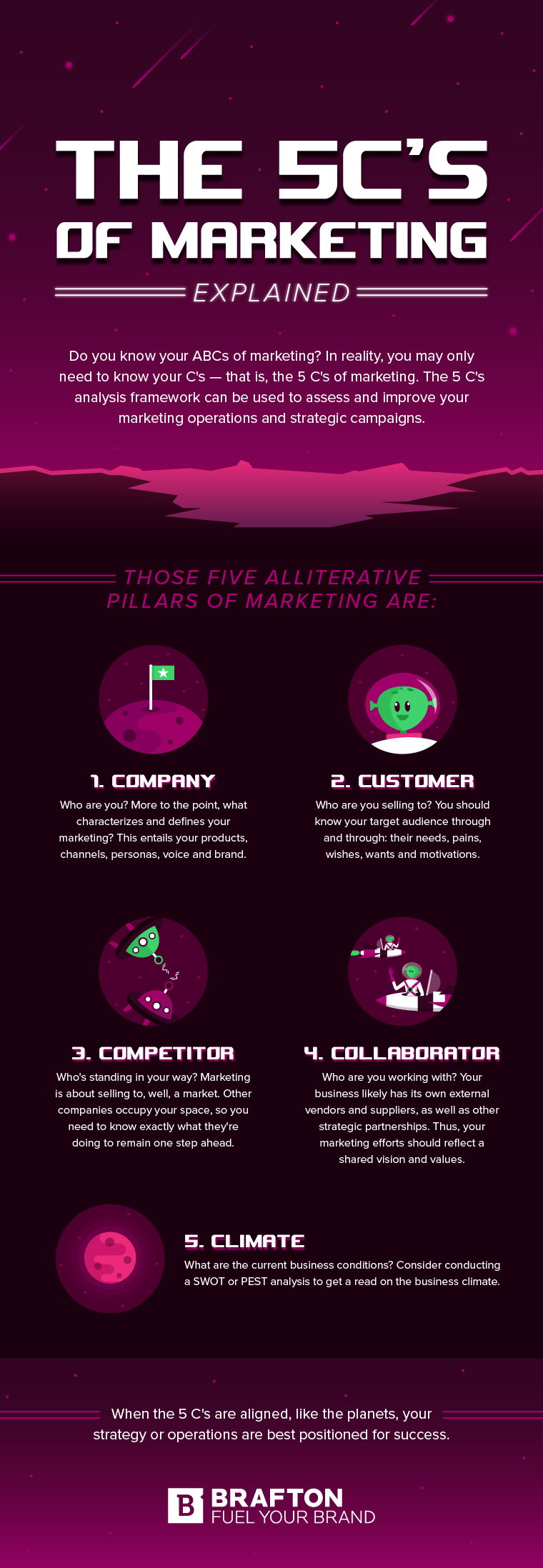
A Detailed Look at Each of the 5 C’s
The best part about integrating the 5 C’s into your marketing strategy is that this isn’t a dry analysis that stifles creativity. Instead, it helps you develop strong insights into key areas of your company’s strengths while better understanding how to develop a competitive advantage relative to other players in the marketplace. It can also help you refine your key performance indicators (KPIs) as you devise and implement new marketing strategies.
Time to take a look at that first C.
Subscribe to
The Content Marketer
Get weekly insights, advice and opinions about all things digital marketing.
Thank you for subscribing to The Content Marketer!
The First C: Company
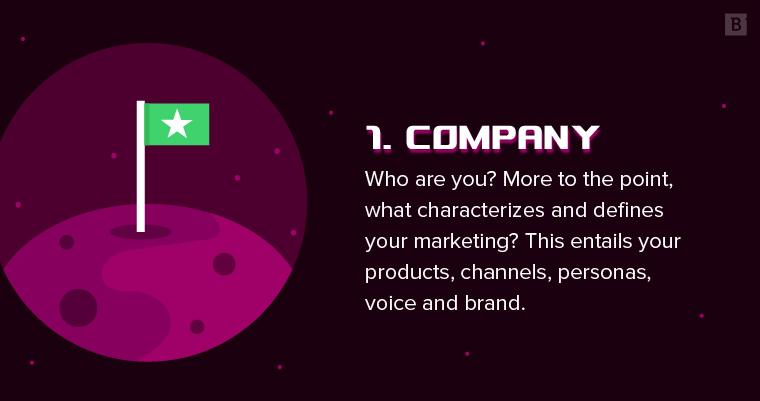
Why did we start with “company”? Because we think it’s always important to check in with yourself. Go ahead, take a deep breath, and get ready to look inward.
Some 5C adherents rank “capabilities” among the elements of their analysis. For our purposes, we’ll view that term as being largely synonymous with the “company” category.
That’s because, in this section, you’ll take stock of how your business operates, including its:
- Product lines and offerings.
- The marketing mix you use to position those products.
- Communication channels you’re currently leveraging and those you want to explore.
- Key influencers for marketing decisions, including representatives from sales, operations and customer service.
You’ll notice that we’re placing a heavy emphasis on marketing operations here. While you may also want to include factors like company financials, research initiatives and product innovation, the heft of your review should be centered on what you have to sell and how you can share it with your potential customers.
The Second C: Customer
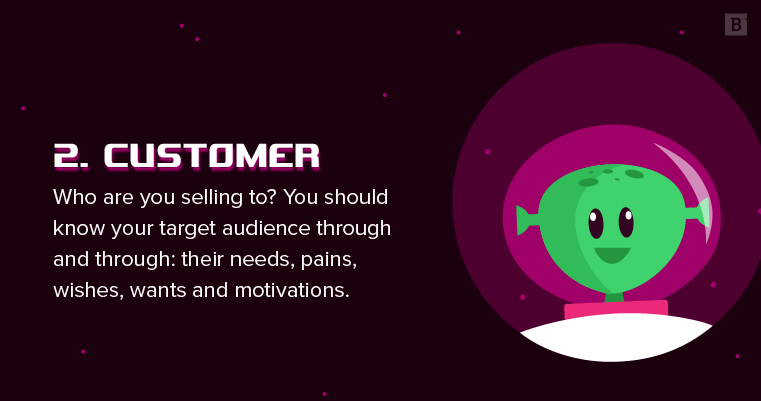
That’s right. Customers may be second on this list, but they’re first in our hearts.
The second part of your analysis should be focused on:
- Understanding customer needs.
- Identifying market segments.
- Developing strategies for interacting with your target audience.
Techniques for checking in with your customers can range from formal research, either conducted internally or through a third-party contractor, to informal Twitter polls. Just make sure they’re actually interactive and that you’re asking the right questions.
Understanding what your customers and prospective clients need, and figuring out how to most effectively reach them, is a big step toward better marketing communication.
The Third C: Competitor
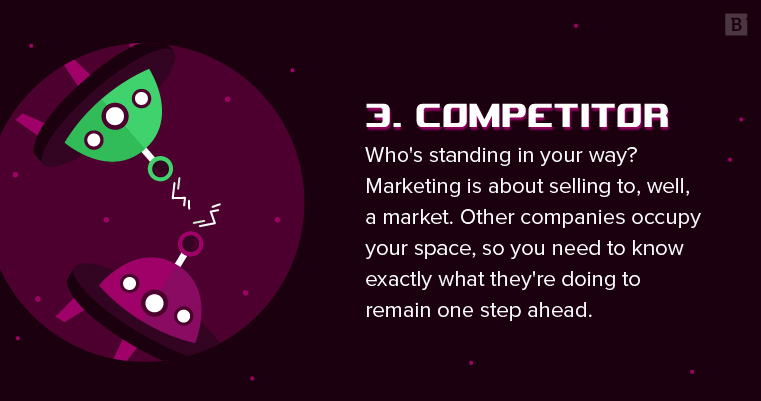
Competitors come next because, next to inner peace and a customer-focused mindset, knowing who you’re up against is the real secret to implementing a solid marketing plan and strategy.
Chances are, no matter how strong your differentiators are, your product lines aren’t totally unique in the market. You may already have a strong sense of who your primary competitors are, but keep an open mind and expand your list if necessary.
Then, make sure you know which digital marketing channels your competitors are using and get to know their social media presence.
Research indicates that 84% of consumers say they’ll buy from a brand they follow on social media instead of from one they don’t.
The Fourth C: Collaborator

Now it’s time to take a look at who’s in your corner.
Take a broad look at the collaborators you currently work with as well as investigating the potential for untapped partnerships.
Businesses that are aligned with you in the marketplace, but aren’t direct competitors, may prove to be valuable partners for creating content. Looking forward and backward in your supply chain can be helpful, too. You’ll likely find a lot of opportunities to work with other companies that have shared interests.
Construct a well-defined plan for pursuing partnerships based on your marketing decisions.
The Fifth C: Climate
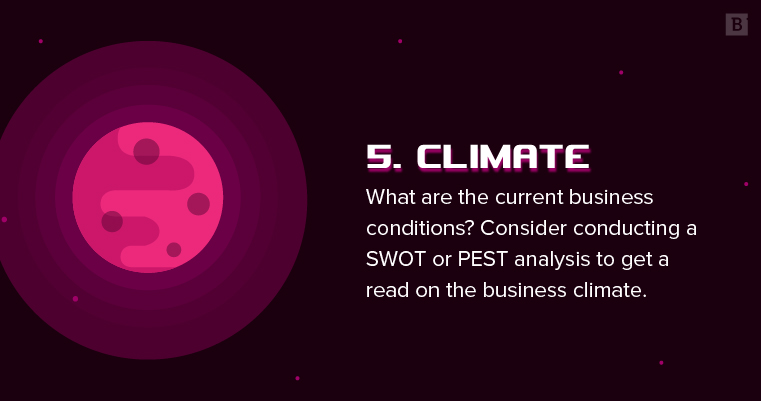
Whether you use the term “climate,” “context” or “conditions,” chances are you’re talking about similar concepts here.
The idea is to really look beyond yourself to get a better understanding of the whole ecosystem in which your company participates. To develop an effective strategy that attracts new potential customers while retaining loyal clients, you have to assess the overall climate.
There are two related situation analyses that can help you get there:
- SWOT: Strengths, weaknesses, opportunities and threats.
- PEST: Political, economic, social and technological.
For instance, if you learn that your customers are already becoming overburdened by email in their professional lives, how do you respond to that threat?
(As an added bonus, conducting a PEST analysis, followed by a SWOT analysis, is how to start building out your marketing plan.)
Analyze the Five Key C’s for an Enhanced Marketing Strategy
Overall, what you decide to do with the 5 C’s is up to you. If you think your content marketing strategy needs a tuneup based on the overall climate in your industry and the tactics you’ve observed among your competition, it’s time to shift in that direction. The point is to take in as much information as you can and to regularly refine your process so it gets better over time.





